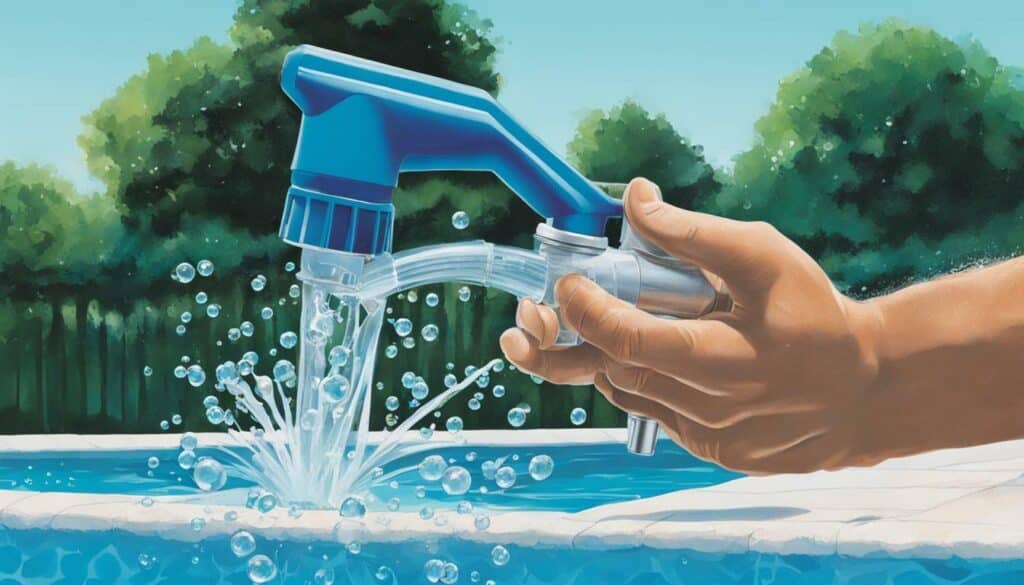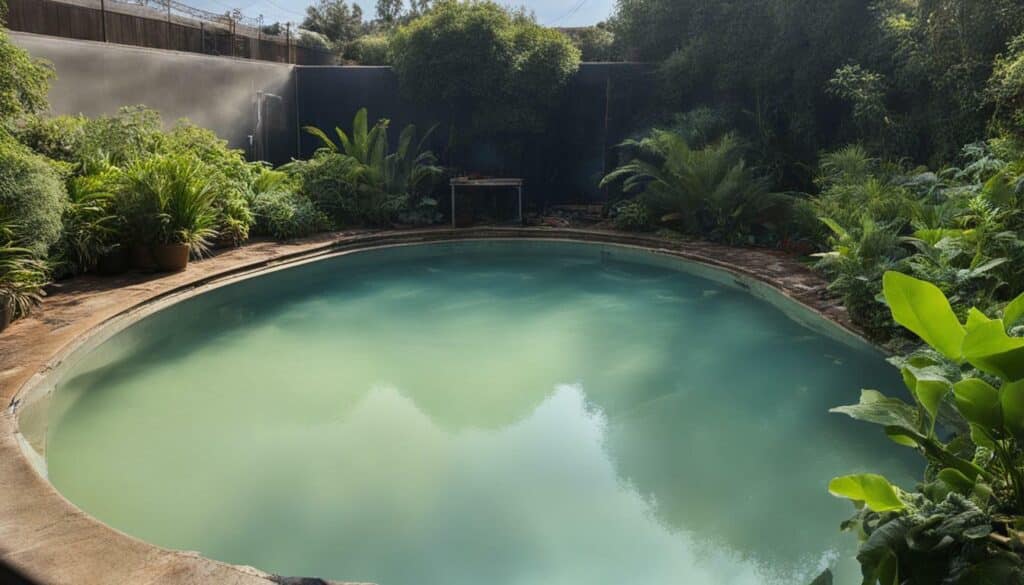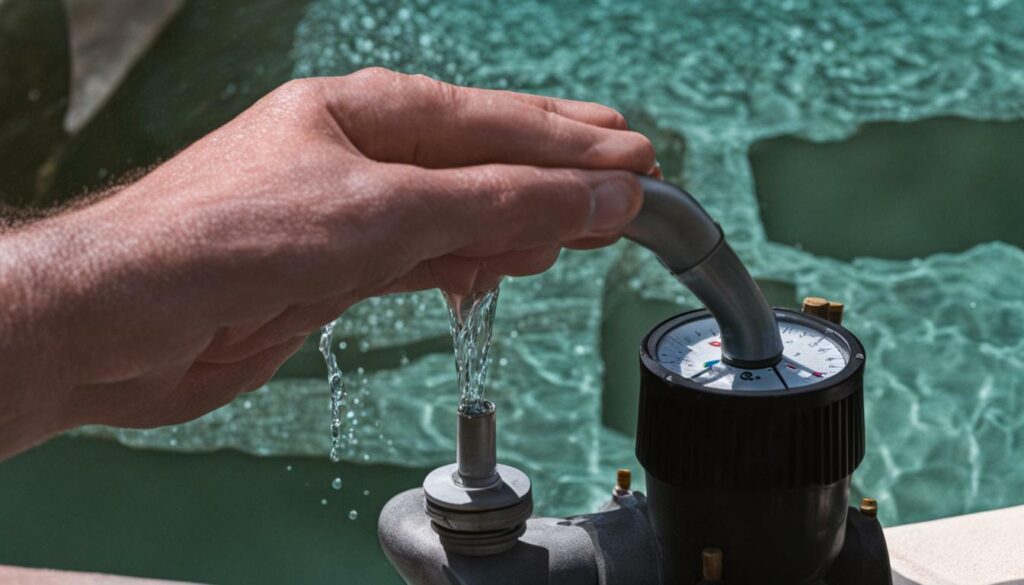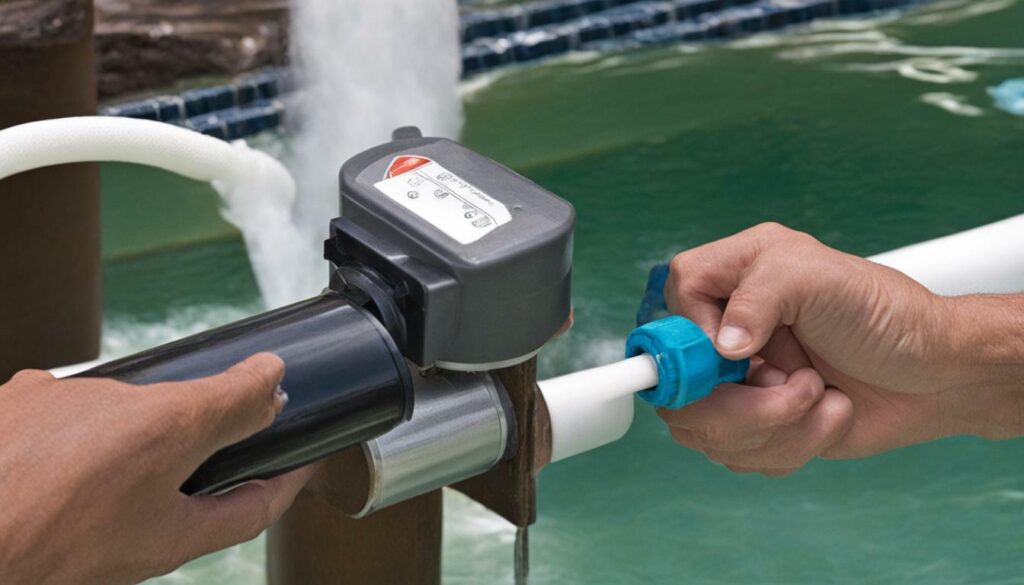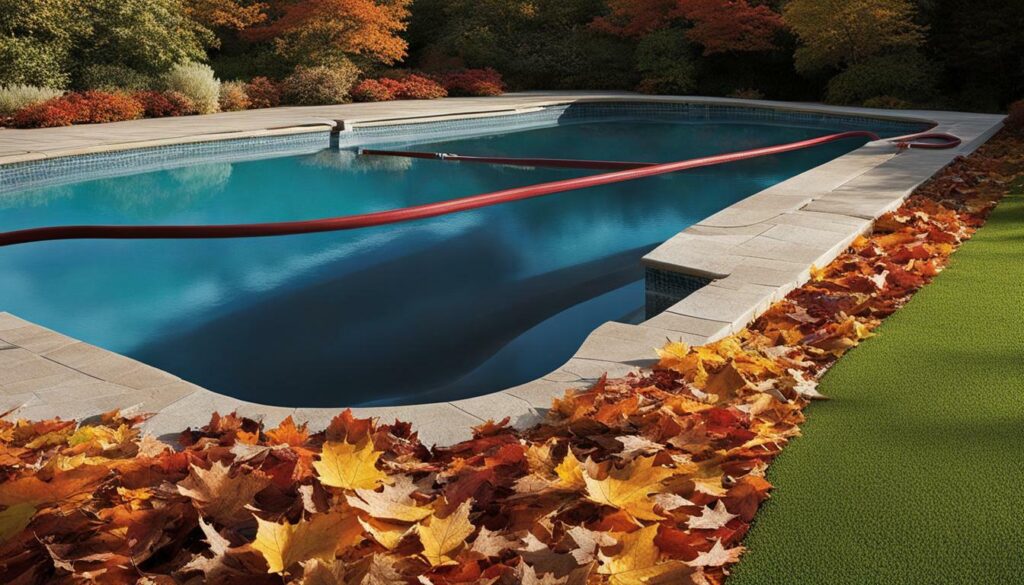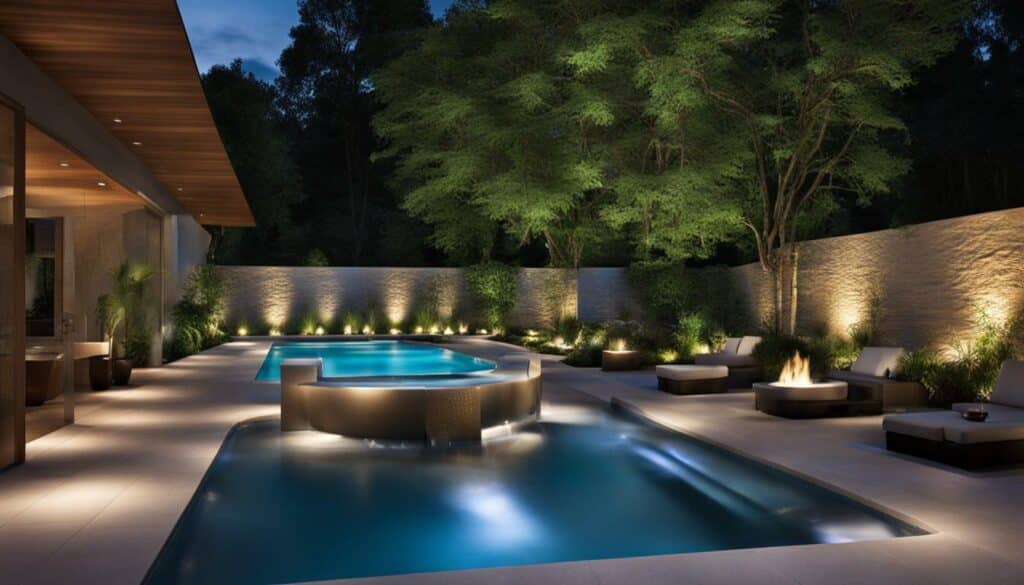
If you own a pool, you know how important it is to keep your pool pump running efficiently. However, air bubbles in the pump can cause priming problems, leading to reduced performance and higher energy bills. Fortunately, there are steps you can take to get air out of your pool pump and restore proper circulation.
In this guide, we’ll discuss the potential causes of air getting into the pool pump and provide you with the necessary steps to remove it. From checking for air leaks to venting the air from the pump, we’ve got you covered. You’ll also learn about maintaining adequate water levels and the importance of regular pool pump maintenance.
- Removing air from your pool pump is essential for maintaining proper functionality.
- Potential causes of air in the pool pump include leaks, clogged strainer baskets, and low water levels.
- Steps for removing air from the pool pump include checking for and fixing air leaks, venting the air from the pump, and bleeding the pump and filter.
- Properly sealing pool pump connections and maintaining adequate water levels can also prevent air-related problems.
- Regular pool pump maintenance is crucial for ensuring efficient and air-free operation.
Understanding Pool Pump Priming Problems
Pool pump priming problems can be frustrating for any pool owner. If you’re experiencing issues with your pool pump, it’s important to understand why they occur and how to troubleshoot the problem to get your pool back in working order. One common cause of pool pump issues is air getting trapped in the filter.
When air enters the pool pump, it can cause the pump to lose prime, resulting in poor circulation and water clarity. To fix any problems with your pool pump, you’ll need to identify the root cause of the air space and take appropriate steps to remove the air.
Common Causes of Air in Pool Pump Filter
Understanding the common causes of air in the pool pump filter is the first step toward troubleshooting the problem. Some of the causes include:
- Air leaks in the suction side plumbing or pump lid o-ring
- A clogged or dirty strainer basket
- Low water levels
- Improperly sealed connections
- Pump seal failure
By identifying the cause of the air in your pool pump, you can take appropriate steps to address the issue and prevent future problems
Troubleshooting Pool Pump Air Issues
To troubleshoot problems with air in your pool pump, you should:
- Check for air leaks in the suction side plumbing or pump lid o-ring
- Clean and check the strainer basket for debris
- Make sure the water level in the pool is at the proper level
- Properly seal all connections between the suction side plumbing and the pool pump
- Check the pump’s seal for failure and replace it, if necessary
Taking these simple steps can help you identify and address any air problems in your pool pump system. Once addressed, your pool pump should operate efficiently and effectively, providing you with crystal clear water all season long.
If you’re noticing air in your pool pump, one of the common culprits is air leaks in the system. Air leaks occur when the seals, gaskets, or O-rings in your pool equipment fail to create a tight seal, allowing air to enter the pump. This can lead to a range of issues, including reduced efficiency, loss of prime, and air bubbles in the filter.
To fix the problem, you’ll first need to locate the air leak. Begin by inspecting all the connections between the pool pump, filter, and other equipment for visible cracks, gaps, or loose fittings. You can also check for leaks by spraying a soapy water solution on the connections while the pump is running. If you see bubbles forming, you’ve found the leak.
Once you’ve identified the source of the leak, you’ll need to fix it. This can involve replacing damaged parts, tightening loose fittings, or applying a sealant to the connection. If the leak is due to a damaged seal, you’ll need to replace it with a new one that matches the make and model of your pool equipment.
Regularly checking for and addressing air leaks can help prevent air from getting into your pool pump in the first place, ultimately saving you time and money in the long run.
Once you’ve addressed any potential air leaks in the pool pump system, it’s time to move on to venting the air from the pump itself. Venting the pump will help to restore proper circulation and eliminate any remaining air bubbles. Follow these steps to remove air from your pool pump:
- Turn off the pool pump.
- Locate the air release valve on top of the filter tank.
- Slowly open the valve using a wrench or pliers until air starts to escape.
- Let the air escape until water begins to trickle out of the valve.
- Close the valve and turn the pump back on.
If necessary, repeat this process until all air is removed from the pump.
It’s important to note that if you have added any chemicals to the pool recently, such as chlorine or shock, you may need to repeat this process more than once to ensure that all air is removed from the system.
Now that you’ve vented the air from your pool pump, it’s time to check for any loss of prime or other related issues. If you’re still experiencing problems, proceed to the next section for further troubleshooting.
Bleeding the Pump and Filter
If you’re experiencing a loss of prime in your pool pump, you may have air trapped in the system. Bleeding the pump and filter can help remove the air and restore proper circulation.
To bleed the pump and filter, follow these steps:
- Turn off the pool pump and wait for it to cool down.
- Locate the filter air release valve at the top of the filter.
- Turn the valve counterclockwise to open it.
- Be prepared for water and air to come out of the valve.
- Once the water starts to come out, wait for a steady stream to form without any air bubbles.
- Close the valve by turning it clockwise.
- Turn on the pool pump and check the pressure gauge.
- If the pressure is still low, repeat the process until the pressure is back to normal.
Bleeding the pump and filter is a quick and simple process that can solve air-related problems and prevent the pool pump from losing prime.
If you’re still experiencing air bubbles in your pool pump, a clogged or dirty strainer basket may be to blame. Over time, debris and leaves can accumulate in the basket, impeding water flow and causing a loss of prime. Before attempting to clean the strainer basket, turn off the pool pump and release any pressure in the system.
Next, locate the strainer basket, which is typically located near the pool pump. Depending on your specific model, you may need to use a wrench to loosen the lid. Once the lid is removed, carefully remove the strainer basket and dispose of any debris inside.
Using a garden hose, rinse the strainer basket and lid thoroughly, ensuring that all debris is removed. If the basket is particularly dirty, you may need to use a mild detergent or cleaning solution to fully clean it. Be sure to rinse the basket and lid again once you’re finished cleaning.
Once the basket and lid are clean, reassemble the strainer and ensure that the lid is tightened securely. Turn on the pool pump and monitor for any air bubbles or loss of prime. If the problem persists, you may need to check for air leaks or bleed the pump and filter.
Air can enter your pool pump system if there are loose or improperly sealed connections. To prevent this problem, ensure that all connections are tightened and sealed properly. Start by inspecting all connections, such as those between the pump and strainer, and between the strainer and pool. If any of these connections are loose, tighten them with a wrench or pliers, making sure not to overtighten.
Next, examine the pump lid and O-ring. To access the O-ring, remove the lid and inspect it for any signs of wear or damage. If the O-ring appears worn or damaged, replace it with a new one. Apply a thin layer of silicone lubricant or petroleum jelly to the O-ring to ensure a proper seal.
It’s also important to check the valve connections. These are the pipes that connect the pool’s skimmer and return to the pump. Ensure that these connections are tightened and sealed properly, as leaks in these areas can cause air to enter the system.
By sealing all connections properly, you can prevent air from entering the pool pump system and causing priming problems. If you’re still experiencing issues with air in your pool pump filter or losing prime, consider checking other potential causes discussed in this guide.
Another common reason for air getting into your pool pump is low water levels. When the water level is too low, it can cause air to enter the pump, leading to priming issues and decreased efficiency.
To prevent this problem, make sure to maintain adequate water levels in your pool. Check the water level regularly and fill the pool to the recommended level as needed.
Additionally, you may want to consider investing in an automatic pool water leveler. This device helps maintain consistent water levels and ensures that your pool pump is always receiving the water it needs to operate smoothly.
By taking steps to maintain proper water levels, you can prevent air-related issues and help your pool pump run efficiently.
In addition to addressing air-related issues, regular maintenance is crucial for ensuring your pool pump operates smoothly and efficiently.
To keep your pump in top condition, be sure to follow the manufacturer’s recommended maintenance schedule. This may include tasks such as cleaning the filter, lubricating moving parts, and checking for leaks.
Additionally, keep an eye out for any signs of wear and tear, such as cracks or corrosion. Addressing these issues promptly can help prevent more serious problems down the line.
By staying on top of regular maintenance tasks, you can help prevent air bubbles and other issues in your pool pump, ensuring that it operates efficiently and effectively for years to come.
Regular Pool Pump Maintenance
Proper and regular maintenance of your pool pump is essential for preventing air bubbles and other issues. Here are some key tips to get started:
- Keep your pool pump clean by regularly removing debris and dirt.
- Check the pool pump’s motor and electrical connections to ensure they’re secure and in good condition.
- Inspect and clean the pool pump’s impeller to ensure smooth operation and prevent clogs.
- Lubricate the pool pump’s O-rings for a tight seal and prevent air leaks.
- Regularly check the pool pump’s pressure gauge and clean the filter when necessary.
Regular pool pump maintenance not only prevents air bubbles but also extends the life of your pump and improves overall pool efficiency. By taking the time to properly care for your pool pump, you’ll minimize the risk of costly repairs in the future.
Conclusion
Dealing with air in your pool pump can be frustrating, but it doesn’t have to be a headache. By following the steps outlined in this guide, you’ll be able to eliminate air bubbles and prevent any related problems.
Remember to check for air leaks, vent the air from the pump, bleed the pump and filter, and maintain adequate water levels. Additionally, regular maintenance is key to ensuring your pool pump operates efficiently and air-free.
Take Action Now
Don’t let air in your pool pump ruin your swimming experience. Take action today to ensure your pump runs smoothly and efficiently all season long.
By following the tips and tricks outlined in this guide, you’ll be well on your way to a perfectly functioning pool pump. Happy swimming!
FAQ
Q: How can I remove air from my pool pump?
A: To remove air from your pool pump, you can follow these steps:
Q: What causes priming problems in pool pumps?
A: Priming problems in pool pumps can be caused by air getting trapped in the filter. This can occur due to various factors such as leaks or clogged strainer baskets.
Q: How can I check for air leaks in my pool pump?
A: To check for air leaks in your pool pump, you can inspect the system for any signs of leakage and use methods like applying soapy water to identify the source of the leak.
Q: How do I vent the air from my pool pump?
A: Venting the air from your pool pump involves opening the air relief valve and allowing the air to escape until water starts flowing steadily.
Q: How can I bleed the pump and filter to remove trapped air?
A: To bleed the pump and filter, you will need to locate the air bleed valve, open it while the pump is running, and close it once all the air has been released.
Q: How do I check and clean the pool pump strainer basket?
A: Checking and cleaning the pool pump strainer basket involves turning off the pump, removing the basket, rinsing it with water, and removing any debris or clogs.
Q: How can I properly seal pool pump connections to prevent air?
A: To properly seal pool pump connections, you can use Teflon tape or sealant to ensure a tight and leak-free connection between the pump and other components.
Q: Why is maintaining adequate water levels important?
A: Maintaining adequate water levels in the pool pump is important to prevent air from entering the system. Low water levels can lead to air getting sucked into the pump and causing priming issues.
Q: How often should I perform maintenance on my pool pump?
A: It is recommended to perform regular maintenance on your pool pump, including cleaning the filter, checking for leaks, and inspecting the strainer basket, at least once a month or as needed.
Q: How do I ensure my pool pump operates efficiently?
A: To ensure your pool pump operates efficiently, it is important to follow a regular maintenance schedule, maintain proper water levels, and promptly address any air or priming issues that may arise.







